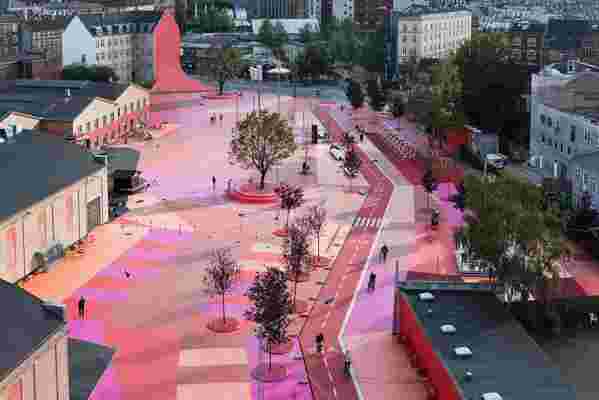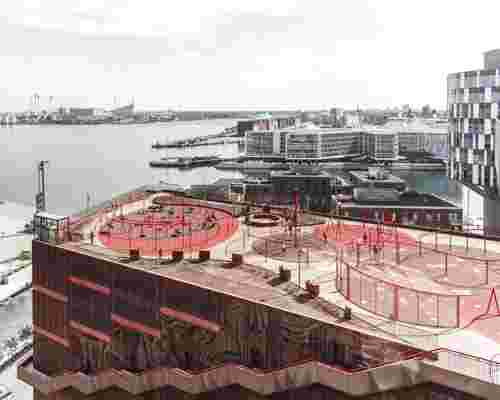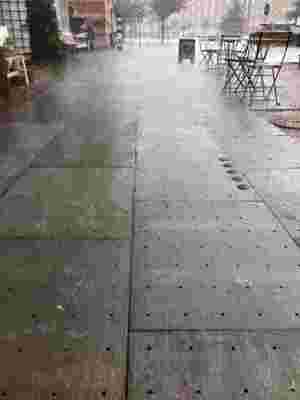November 16,2022
5 Definitive Ways to Create Better Cities
by David Stewart
As we face not one but two global crises—the COVID-19 pandemic and climate change— The Ideal City , a new book by Space10 (IKEA’s research and design lab in Copenhagen) published by Gestalten explores the ways architects, designers, and urban planners are forging ahead in a quest to create better cities for the future. “Our cities are a massive driver of the climate crisis; we have an affordable housing crisis in every major city around the globe; we’re not meeting the needs of the people who are actually living in cities; and despite living closer together, we experience increased loneliness, depression, and stress within our cities—so we really wanted to explore how can we actually solve this,” Simon Caspersen, cofounder and communications director of Space10, said during the virtual book launch earlier this month.
While acknowledging that utopia doesn’t exist, and that top-down urban planning isn’t necessarily the right approach, Space10 puts forth a number of ways to improve existing cities and create new building models for undeveloped areas. The book is structured around five chapters that examine key aspects of the ideal city and features projects from 53 cities around the world that offer solutions to some of the most pressing problems facing urban areas today. Ahead, five ways to create better cities for the future.

The new book breaks down ways to make urban spaces more inclusive and, thus, desirable for large swaths of the population.
Making Cities More Resourceful
According to the book, the ideal city must first and foremost be resourceful. That means it must be ecologically and economically sustainable, goals that can be achieved by closing the loop on energy, water, and food production. The Copenhagen Harbor Bath and CopenHill by AD100 architect Bjarke Ingels provide two shining examples.
The only way that you can make sustainability win is if you make it more desirable and more enjoyable, essentially more successful than the alternative —Bjarke Ingels
The former cleans and filters the water in Copenhagen Harbor while providing a public space for people to swim and relax, while the latter is the landmark waste-to-energy plant with a green roof that becomes a ski hill on top. “The only way that you can make sustainability win is if you make it more desirable and more enjoyable, essentially more successful than the alternative,” Ingels—a proponent of “hedonistic sustainability”—said during the virtual book launch.

Copenhagen has become an example of how smart urban planning and innovative architecture can create a meaningful impact on a city, its population, and the environment.
Making Cities More Accessible
The second chapter posits that cities should encourage diversity, inclusion, and equality among their residents. That means ensuring that everyone has equal access to urban amenities, health care, education, employment, culture, leisure, sport, nature, and—perhaps most important—affordable housing. The authors note that 1.5 million people move into urban areas around the world every day, but many cannot afford to live close to urban opportunities and end up pushed to the fringes.
“I stumbled upon this statistic recently that in the urban areas of America it takes the median-income person 27 years on average to save up the 20% down payment to be able to buy a median-priced-owner apartment or condo in a city,” Ingels said. “So that means that hard-working, well-educated, by all standards successful and contributing citizens actually have a hard time getting access to owning a home, which of course is not the only way to have a life, but it’s been a good way to be anchored in a community, have a sense of ownership and belonging, to make a community less transient and therefore more sustainable, and to eventually make possibilities for later generations, so I think there’s something to be looked at in this entire value chain that provides the spaces we live in and that we call home that could need a 21st century upgrade.”
As featured in this chapter, the Starter Home project by the Office of Jonathan Tate seeks to make entry-level homes appealing and affordable by building on overlooked sites in established neighborhoods, like New Orleans’s Irish Channel neighborhood. By creating tailor-made dwellings in challenging sites, architects can encourage economic diversity in rapidly gentrifying areas.

Sidewalks with holes can help collect rainwater and help avoid runoff and flooding.
Sharing Space and Resources
With co-working spaces and rideshare companies becoming ubiquitous in cities around the world, there’s much talk about the sharing economy. This chapter goes even further, arguing that “the ideal city shares a lot more than just spaces. It also shares services, skills, finances, transportation, and energy, and it uses models of ownership and access that are geared toward the public good.”
One particularly beautiful project featured is the Microlibrary Warak Kayu in Semarang, Indonesia by SHAU Indonesia . Raised on wooden columns with latticework made from local wood, the library provides access to knowledge through books, movies, and community events to residents of Indonesia’s poorest communities. The architects incorporated playful elements, such as netted hammock-style flooring, to make the space appealing to kids and encourage families to use this shared space for learning.
Making Cities Safer
This chapter proposes that in addition to lowering crime, cities need to protect their citizens against extreme weather events and provide a healthy environment that fosters physical and mental well-being. It highlights a small project that makes a big impact: the Tokyo Toilet, a series of 17 public restrooms designed by renowned architects in Tokyo’s Shibuya district. By incorporating colored glass that’s transparent when the lavatory is empty and opaque when in use, Pritzker Prize–winning architect Shigeru Ban’s design addresses two basic concerns people have with public toilets: cleanliness and how to know if someone’s inside.
Bjarke Ingels’s CopenHill has become the leading example of how eco-friendly structures can be met with high design.
Making Cities More Desirable
The last chapter highlights some of the things that make cities appealing and fun to live in, emphasizing that the best cities are designed on a human scale with a focus on people, not cars. According to Space10, cities should have public spaces that encourage people to interact, as well as mixed-use neighborhoods in which everything residents need is available within a 15-minute walk.
“I’m actually a little bit encouraged by some of the changes we’ve seen under the COVID-19 crisis,” Helle Søholt, cofounder and CEO of Gehl Architects , the firm behind the pedestrianization of New York’s Times Square, said during the virtual book launch, explaining that Gehl conducted surveys of public life in cities around the world in April and July of last year. “What we are seeing right now—obviously became people are working from home—we are seeing a sort of return to localism that there could be a potential to on the other side of COVID-19 too, where we are learning to use our local neighborhoods and local communities in new ways. Maybe we can return to more 24-hour neighborhoods where people are living closer to where they work and we can start redesigning our communities and streets so that we are promoting walkability and cycling in a proper way.”






